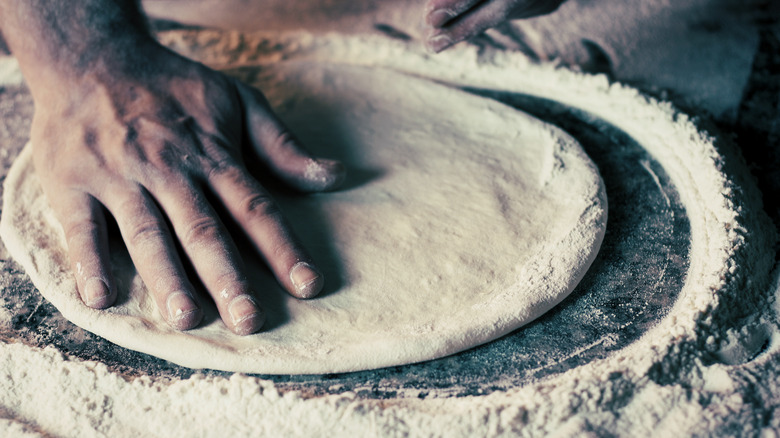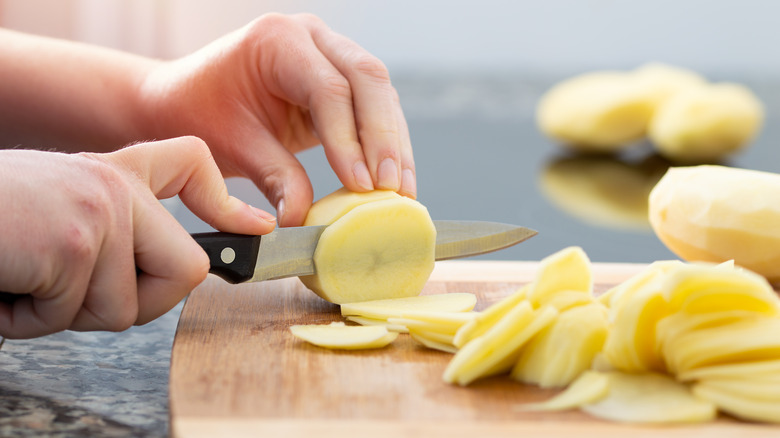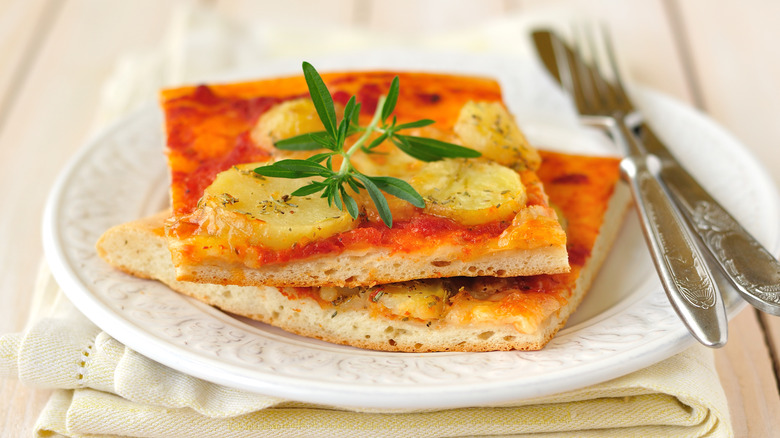Italy's Potato Pizza Is Simple, Crispy Perfection
The world's steadfast obsession with pizza is nothing new. The earliest forms of pizza can be traced back to the Campania region of Italy. A variety of cultures have explored the fundamentals of pizza, employing different techniques and toppings to make it their own. The versatile dish caters to all tastes and has become the unspoken go-to meal of the modern world.
Most people probably associate pizza with a classic red sauce, but Italy has been celebrating other versions for centuries. Among them is the lesser-known, perfectly crispy, potato pie. Before you question its authenticity, potato-topped pizza was born in the pizza capital of the world, Naples, in the early 1900s.
While the approach may be different, potato pizza stays true to the Neapolitan style by sticking with regional ingredients and a thin, airy crust. The savory potato pie was originally crafted with cost in mind, but its elevated taste would never suggest that.
The story behind Italy's most underrated pizza
Neapolitan potato pizza was actually the result of an innovative discovery: bakery floors were hot enough to slowly bake. Around the turn of the 20th century, many Neapolitan families living in more impoverished neighborhoods were crowded into small, oven-less homes. A common struggle among locals, they set out to find creative alternatives to using ovens.
Apparently, local bakeries were gracious enough to let the community use their facilities to feed their families, without costing anyone a dime. The heat from wood-fired ovens was strong enough to raise the temperature in an entire bakery, including the floors. Folks would lay a large sheet down right on the bakery floor, stretch their yeast-less dough across it, and let it bake slowly.
Considering there was no real way to control the temperature, the outcome was a bit wonky. The slowly baked dough resulted in a paper-thin crust, so they bulked it up with budget-friendly potatoes. They layered thinly sliced potatoes atop each other to enhance the crust, and voila — the delicious potato pizza was born.
True to Neapolitan style, tomato sauce and mozzarella cheese were often added. Thankfully, ovens are now commonplace and potato pizza can be a welcome addition to a DIY pizza party at home. What began as a budget-friendly dinner option for families has evolved into an Italian classic that can be found all over the country. It's especially popular in Rome where it's typically served sans tomato sauce.
The secrets to the unique culinary creation
When it comes to toppings, Italy has notoriously kept it minimal, and it doesn't get much more straightforward than potato pizza. As legendary pizza chef Franco Pepe confidently stated in his "Chef's Table: Pizza" episode when speaking of his Margherita, "Fantastic in its simplicity."
The traditional ingredients of a potato pizza are flour, salt, and potato. Aside from the starchy topping, the dough differs only slightly from Neopolitan pizza by upping the salt content by nearly 50%. Initially, the sauce and cheese weren't a big focus, but if made in its hometown of Naples, it should feature San Marzano tomatoes and fresh mozzarella cheese.
With today's ease of oven access, potato pizzas are baked in the same manner as classic Neapolitan pies — tossed right on a pizza stone in a blazing wood-fired oven for no more than a few minutes. That high heat gives us that perfect, light, airy crust. While tradition and authenticity are still celebrated, chefs continue to explore new approaches to potato pizza.
David Lebovitz recreated the Italian dish more closely aligned with the Roman style, which is heavy on rosemary and tomato-free. His rendition of the classic potato pie is a bit more rustic, as he doesn't bother peeling the potatoes and slices them with a knife rather than a mandolin. Lebovitz favors a crispy crust as opposed to the authentic thin, chewy type. He achieves this by placing it on a baking sheet rather than tossing it right in the fiery oven.
Indulge in the delicious crispy goodness at home
If jetting off to Italy isn't on the cards, this simple yet scrumptious pizza can be made at home using basic ingredients. With potatoes sliced as thin as the crust itself, there's no need to par-boil or bake them beforehand. The thin nature allows the slices to roast at the perfect temperature, resulting in a complex layered crust and crispy potato chips on top.
That said, some like Deb Perelman of Smitten Kitchen suggest softening the potatoes with a saltwater bath, which also keeps the edges from burning. Similar to David Lebovitz, Perelman's take is more closely aligned with the Roman version which she likens to a spin on Roman bread, also known as pizza bianca. Taking this approach is easy at home as it doesn't require a wood-fired oven.
Considering Roman-style pizza is traditionally yeast-less and loaded with olive oil, the potato-topped pizza craze in Italy's capital comes as no surprise. While Neapolitan pizza typically rises with yeast, the infamous potato pizza does not, as its illustrious past indicates.
"Today, pizza is also made with your head. You have to understand the combinations, the balances, how to bring the thrill of a flavor to the palate," Franco Pepe explained in "Chef's Table: Pizza."



